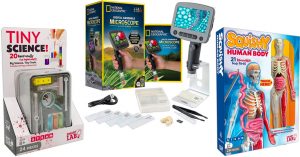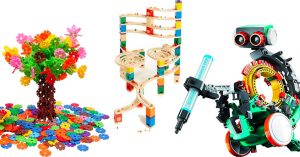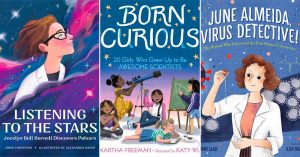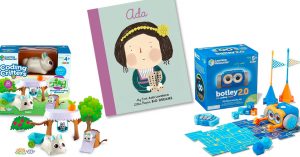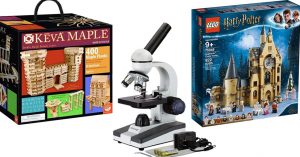The "Women of NASA" Lego Set has become one of this year's top toys -- now learn the inspiring stories of these trailblazing scientists!
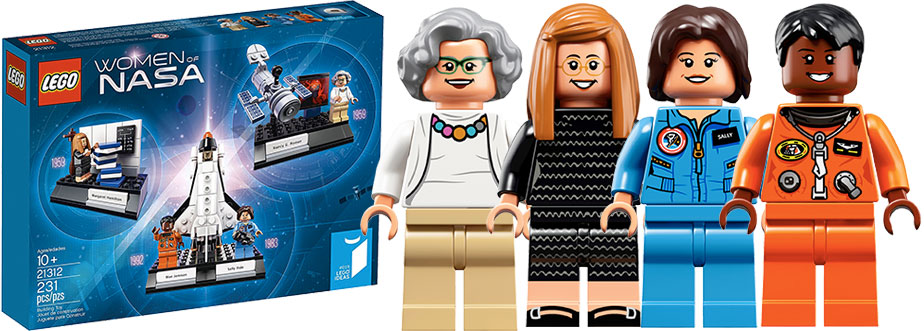 When LEGO released their Women of NASA Building Set last month, it was a sensation. Our Facebook post announcing its release quickly went viral. The set became Amazon's bestselling toy and sold out within a day, showing the strong demand for science toys with female scientists at the forefront!
When LEGO released their Women of NASA Building Set last month, it was a sensation. Our Facebook post announcing its release quickly went viral. The set became Amazon's bestselling toy and sold out within a day, showing the strong demand for science toys with female scientists at the forefront!
The set features four pioneering women who made major contributions to the U.S. space program: astronomer and educator Nancy Grace Roman; computer scientist Margaret Hamilton; astronaut and physicist Sally Ride; and astronaut, physician, and engineer Mae Jemison. The 231-piece set, created by LEGO fan and science writer Maia Weinstock, includes minifigures of all four women and buildable models of the Hubble space telescope and a space shuttle.
Weinstock, who first proposed the set on LEGO's crowdsourcing design platform, designed her set to increase awareness of the contributions these women made to the space program and to science as a whole. In her proposal, she wrote: “In many cases, their contributions are unknown or under-appreciated — especially as women have historically struggled to gain acceptance in the fields of science, technology, engineering, and mathematics (STEM)." In a later interview, Weinstock added that she believes it's "critical to have toys that girls can look at and play with and think, ‘that's me!'’ or ‘that could be me!"
The massive popularity of this unique set — the first of its kind since the now discontinued LEGO Research Institute — has generated a sense of excitement and curiosity about the women of America's space program. But while many children and adults may recognize their names, few people know the details of these pioneering scientists' work. In this blog post, we're introducing you to these remarkable women, filling in the details about their careers and why they deserve to hold a special place in space history. We've also recommended books for all ages that let those interested explore their fascinating stories in greater depth. They've been immortalized in LEGO form; now it's time to celebrate the women themselves!
The Women of NASA
Nancy Grace Roman (b. 1925)

At the age of 11, Nancy Grace Roman was already showing her love of astronomy: she founded an astronomy club for her classmates, where they got together once a week to learn about constellations from books. While many people discouraged her interest in science — her guidance counselor in high school once asked her "What lady would take mathematics instead of Latin?" — her parents were supportive and she knew by high school that she wanted to study the stars.
Roman completed a PhD in astronomy in 1949 and spent six years working at the Yerkes Observatory of the University of Chicago. She decided to leave the university, however, after becoming aware of how unlikely it was that a woman would receive tenure. Roman took a position at the Naval Research Laboratory working in radio astronomy and became head of the microwave spectroscopy section. When she was later asked by a NASA official if she knew someone who could create a space astronomy program for the agency, she said she did — and applied personally, becoming the first Chief of Astronomy and the first woman to hold an executive position at NASA.
During her time at NASA, Roman was involved in the launch of several astronomical satellites, including the famous Hubble Telescope; she was so integral to the planning and development of the telescope that she is often called the "Mother of Hubble." Edward Weiler, former director of NASA's Goddard Space Flight Center, once observed that her central role in the program's success is "often forgotten by our younger generation of astronomers who make their careers by using Hubble Space Telescope." Roman worked for NASA for 21 years, and then worked even longer with contractors supporting the Goddard Space Flight Center. She also spent many years speaking to students of all ages, saying, "One of the reasons I like working with schools is to try to convince women that they can be scientists and science can be fun."
Margaret Hamilton (b. 1936)

While today she is most famous as having been the lead software designer for NASA's Apollo space program, Margaret Hamilton began her scientific career as a mathematician. Hamilton intended to pursue a graduate degree in abstract mathematics, but instead she took an interim position at MIT developing weather weather prediction software. There was no training manual; would-be programmers had to figure things out with hands-on experimenting. Hamilton excelled in programming and soon began work on the SAGE Project, where she was one of the programmers developing software to identify unfriendly aircraft on radar. In 1965, she became Director of the Software Engineering Division of the MIT Instrumentation Laboratory and led the effort to develop the on-board flight software for the Apollo space program that NASA wanted to use to help navigate and land on the Moon.
The 1969 Apollo 11 moon landing was the first time in history that software was used to perform such a mission-critical, real-time task and Hamilton's clever programming paid off when an unexpected problem cropped up as Apollo 11 tried to land on the moon. Three minutes before landing, alarms sounded when the computer became overwhelmed with data from an unnecessary radar system that had been accidentally triggered by the crew. Fortunately, Hamilton had not only programmed the computer to recognize such an error, but she also ensured that the software’s priority scheduling could complete high priority tasks -- like preparing for landing -- by ignoring lower priority ones. Writing about the event in 1971, Hamilton said, “If the computer hadn't recognized this problem and taken recovery action, I doubt if Apollo 11 would have been the successful moon landing it was.”
Following the success of Apollo 11, Hamilton worked on many of the subsequent Apollo missions. In 1986, she founded Hamilton Technologies with the aim of expanding on Universal System Language developed for NASA in order to make software more reliable, cheaper, and faster to develop. Hamilton, who was awarded the Presidential Medal of Freedom by President Barack Obama in 2016 for her work on the Apollo missions, also played a major role in making software engineering the respected field that it is today. She explains that she made up the term "software engineering" during her work on the Apollo project: "Software during the early days of this project was treated like a stepchild and not taken as seriously as other engineering disciplines, such as hardware engineering; and it was regarded as an art and as magic, not a science... I fought to bring the software legitimacy so that it (and those building it) would be given its due respect."
Sally Ride (1951 - 2012)

Before she became famous as America's first woman in space, Sally Ride was a multitalented young woman: in addition to being gifted in science, she was a nationally ranked tennis player! Science won out, and she earned both undergraduate and graduate degrees in astrophysics. When NASA announced that they were willing to consider women as astronaut candidates, she was one of over 8,000 people to apply, and she was chosen to join NASA in 1978.
Ride's first shuttle flight was in 1983 — but before she could become the first American woman in space, she had to go through a gauntlet of stereotyped media questions, including "Will the flight affect your reproductive organs?" and "Do you weep when things go wrong on the job?" Ride went to space twice, for a total of over 343 hours; her next flight was cancelled after the Challenger disaster. Instead, she joined the committee investigating the accident and founded NASA's Office of Exploration. After leaving NASA in 1987, Ride became a professor of physics at the University of California, San Diego and director of the California Space Institute. She also co-founded Sally Ride Science, a company dedicated to creating entertaining science materials for elementary and middle school students, particularly girls.
After she died of pancreatic cancer, Ride's obituary revealed that her partner of 27 years was Tam O'Shaughnessy, making Ride the first known LGBT astronaut. O'Shaughnessy has continued Ride's work to encourage girls to pursue science, a fitting tribute to the woman who once said, "I never went into physics or the astronaut corps to become a role model. But after my first flight, it became clear to me that I was one. And I began to understand the importance of that to people. Young girls need to see role models in whatever careers they may choose, just so they can picture themselves doing those jobs someday. You can't be what you can't see."
Mae Jemison (b. 1956)

When young Mae Jemison watched the Apollo moon landing from her home in Chicago, she knew it was unfair that there were no women astronauts. "People tried to explain that to me, and I did not buy it," she recalls. However, she still set her sights on a career in the science, and Jemison entered the chemical engineering program at Stanford University at the age of 16. Briefly, her love of dance warred with her desire to go to medical school; however, her mother advised her, "You can always dance if you're a doctor, but you can't doctor if you're a dancer."
Jemison completed her Doctor of Medicine degree in 1981 at Cornell Medical College, then joined the Peace Corps and spent two years in Liberia and Sierra Leone. While she was away, Sally Ride became the first American woman in space, rekindling Jemison's interest in becoming an astronaut herself. The Challenger disaster delayed Jemison's application, but she was accepted in 1987 as one of fifteen candidates chosen out of over 2,000 applicants. She traveled to space on STS-47 in 1992, spending 190 hours in space, becoming the first woman of color to travel beyond Earth's atmosphere. Jemison once shared how the first thing she saw from space was her hometown of Chicago, explaining that it was an especially significant moment for her because "since I was a little girl I had always assumed I would go into space."
Jemison left NASA in 1993 to found her company the Jemison Group, which researches science and technology for everyday life and sponsors programs for science education. She also took delight in becoming the first real-life astronaut to appear on the TV show Star Trek: The Next Generation; she is a lifelong fan of the sci-fi franchise and was long inspired by the character of Lieutenant Uhura in the original series. Today, Jemison continues pursuing her interest in space as the principal of the 100 Year Starship which aims to support the research needed for humans to embark on a new space adventure: interstellar travel!
Additional Recommended Resources
- The 231-piece Women of NASA LEGO Building Set is highly recommended for ages 10 and up.
- For more books about girls and women with their eyes on the stars, visit our Space & Physics Book Collection.
- For toys to encourage an interest in science, technology, engineering, and math (STEM), visit our Science Toy Collection.










